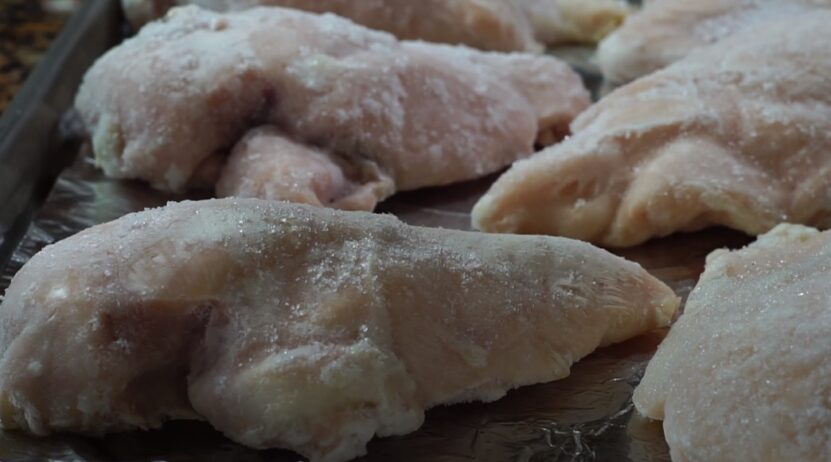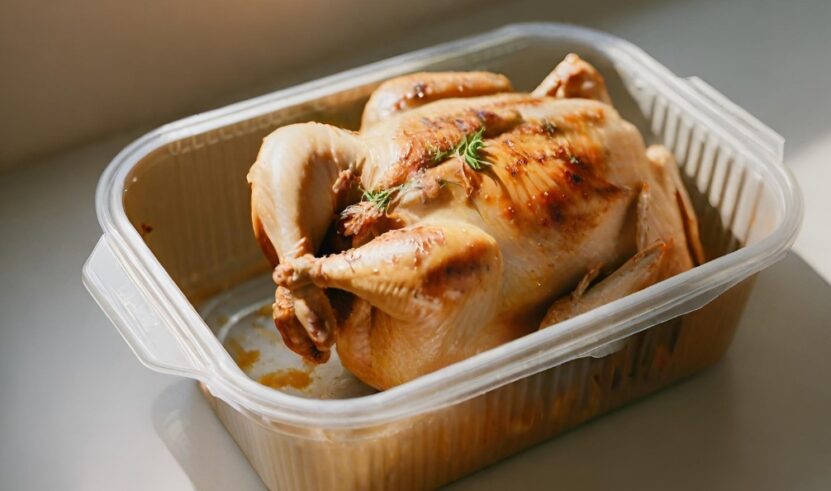A “sell-by” date on a chicken package is an indicator for stores, not necessarily a safety guide for consumers. It’s the date until which a store should display the product. After this date, the quality might decline, but it doesn’t automatically mean the meat is unsafe to eat.
Many people believe that food is unsafe after the sell-by date, but this isn’t always true. Sell-by dates are about quality, not safety. Chicken can be safe beyond this date if stored properly.
Refrigerated Chicken
In the refrigerator, raw chicken, whether whole or in parts, generally remains good for 1-2 days beyond the sell-by date. This timeframe holds true as long as the fridge maintains a consistent temperature of 40°F (4°C) or below.
Cooked meat, on the other hand, has a slightly longer refrigerator shelf life and can last for 3-4 days. It’s important to store cooked meat in shallow, airtight containers to prevent bacterial growth.
Furthermore, avoid leaving cooked chicken at room temperature for more than two hours, as this can accelerate spoilage.
Frozen Chicken

Freezing the meat extends its shelf life significantly. If you freeze your meat prior to the sell-by date, it can remain safe for consumption for up to nine months for pieces and up to one year for a whole chicken.
The key to maximizing the shelf life of frozen chicken is to freeze it as soon as possible after purchase, ideally on the day of buying. Remember, once thawed, don’t refreeze raw meat as this can increase the risk of bacterial growth. For optimal quality, thaw it in the refrigerator, not at room temperature.
How to Store It Properly?

Refrigeration Tips
Proper refrigeration is essential for maintaining the quality and safety of chicken. Always keep it in its original packaging to minimize exposure to air and bacterial contamination. Place it in the coldest part of the fridge, typically at the back, away from the door.
If the original packaging is damaged or not airtight, transfer the meat to an airtight container or wrap it securely in plastic wrap or aluminum foil. This practice not only protects the meat from bacteria but also prevents it from absorbing odors of other foods in the fridge.
Freezing Tips
When it comes to freezing chicken, using airtight containers or freezer bags is crucial to prevent freezer burn, which can deteriorate the quality and texture of the meat. Be sure to label the meat with the date of freezing, as this will help you keep track of its shelf life.
Squeeze out as much air as possible from freezer bags before sealing to maintain the quality of the meat. For added protection, you can also wrap the chicken in aluminum foil or plastic wrap before placing it in a container or bag.
Thaw it in the refrigerator for optimal safety and quality, and avoid using the microwave or thawing it at room temperature.
Signs of Spoilage
Visual Cues

Look for changes in color. Fresh chicken is usually a light pink color, indicating its freshness and suitability for consumption. A grey hue, on the other hand, is a clear warning sign. Beyond the color shift, also watch for any discoloration such as greenish spots or dullness, as these can also indicate spoilage.
If the meat has started to develop a fading or uneven color, it’s best to err on the side of caution and avoid consuming it.
Smell Test
Fresh chicken should have a mild, almost neutral smell, typical of fresh meat. Any strong or off-putting odors are a sign of spoilage and should not be ignored. A sour or ammonia-like smell is a definite indicator that the meat is no longer safe to eat.
Sometimes, even before the smell becomes overtly unpleasant, a slight change in its typical scent can suggest the beginning stages of spoilage. Trust your nose; if something smells off, it’s better to discard the meat rather than risk foodborne illness.
Texture Check
If the chicken feels slimy or tacky to the touch, it’s a sign that it’s no longer good to eat. This sliminess often persists even after rinsing the meat, which is a clear indication that bacteria have started to multiply on its surface.
Additionally, if the surface feels unusually sticky or if the meat feels overly soft or mushy, it’s a sign of degradation. Remember, fresh chicken should have a firm texture and not leave any residue on your hands. If it fails this texture check, it’s best to avoid consuming it to prevent any potential health risks.
Safety Tips

Always use separate cutting boards and utensils for raw chicken to prevent cross-contamination. This means having a dedicated board and knife for raw poultry, separate from those used for vegetables or other cooked foods.
It’s also important to thoroughly wash these items with hot, soapy water immediately after use. Furthermore, avoid placing cooked meat back on the same plate or surface that held raw meat without cleaning it first.
Washing the Meat
Washing chicken can spread bacteria, so it’s best to skip this step and cook it to the appropriate temperature. Splashing water can disperse bacteria from the meat up to a few feet around your sink, contaminating nearby surfaces.
Instead of washing, pat the meat dry with paper towels if you need to remove excess moisture. This practice minimizes the risk of spreading harmful bacteria like Salmonella and Campylobacter.
How to Cook It Properly
Cook chicken to an internal temperature of 165°F (74°C) to kill harmful bacteria. Use a meat thermometer to check the temperature at the thickest part of the chicken, ensuring it’s cooked evenly throughout.
Avoid consuming undercooked meat, as it can lead to foodborne illnesses. It’s equally important to let the meat rest for a few minutes after cooking, as this allows the internal temperature to continue to rise slightly, ensuring thorough cooking.
FAQs
Can I refreeze the chicken after it has been thawed in the refrigerator?
Yes, you can, but it may affect the quality due to moisture loss. It’s best to cook the meat before refreezing to retain better texture and flavor.
How can I tell if the frozen chicken has gone bad?
For frozen meat, signs of spoilage include freezer burn, ice crystals, or a rancid smell upon thawing. If the color has changed significantly or there’s an off-odor, it’s best to discard it.
Is it safe to cook chicken in a slow cooker?
Yes, it is safe as long as the internal temperature reaches 165°F (74°C). However, it’s important to start with properly thawed meat to ensure even cooking.
Can I store cooked chicken in the freezer?
Absolutely! Cooked chicken can be stored in the freezer for 2-6 months. Make sure it’s wrapped tightly in airtight packaging or freezer bags to prevent freezer burn.
What’s the best way to thaw frozen chicken safely?
The safest way to thaw it is in the refrigerator, which can take up to 24 hours depending on the size. Avoid thawing the meat at room temperature as it can encourage bacterial growth.
How long can raw chicken sit out at room temperature?
It should not be left at room temperature for more than 2 hours. In hot environments (above 90°F or 32°C), this time reduces to 1 hour. Bacteria can grow rapidly at room temperature, making the meat unsafe to eat.
Summary
By storing and handling chicken correctly, you can extend its shelf life and enjoy it at its best. Next time you buy chicken, use these guidelines to make smart, safe choices in your kitchen.
